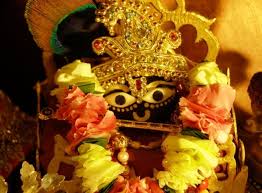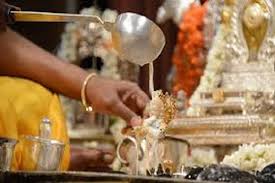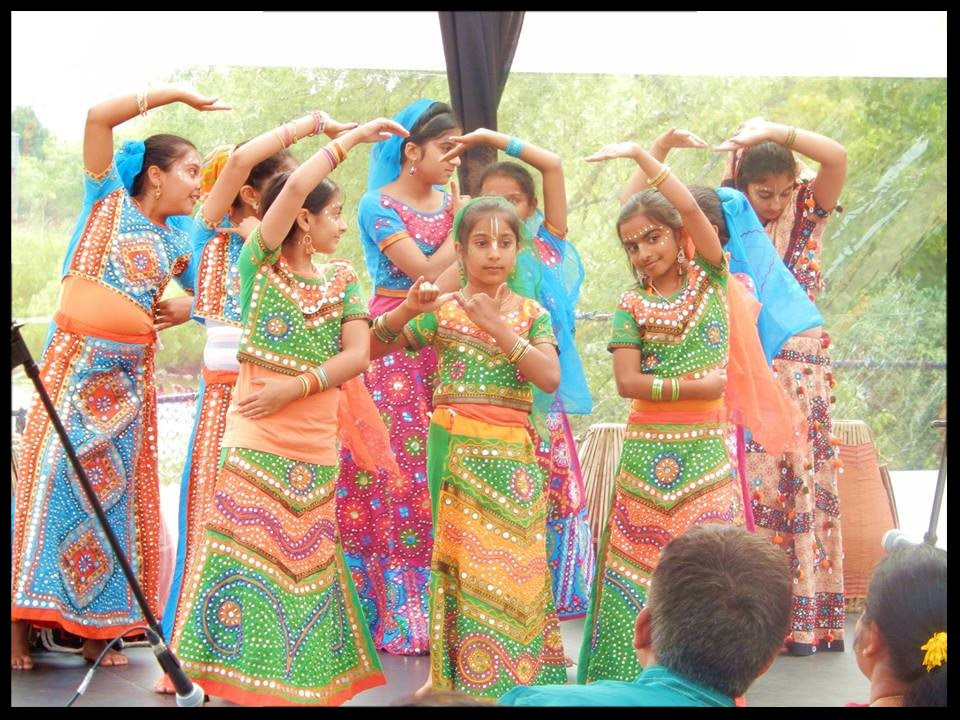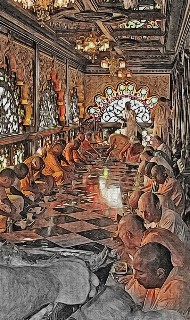Entering the New Year 2016!
By Bhakti-lata Dasi

A month ago, I was in the kitchen, cleaning up after dinner—in the Prabhupada House where we stayed at the time—when there was a knock on the door. My husband answered the door and I heard,
“Is Bhakti-lata there?”
A polite young man entered and he told me,
“I know someone you know”
“Who?”
“Yogi.”
I thought for a second.
“Richard C.?”
“Yes!”
Yogi is the prison name of bhakta Richard (whom we now call Krishna Kirtan). The young man had been in prison with him for a short while. Now that
he was free, he wanted to meet me in person. We talked for a while. It was a very sweet encounter.
Each and every time I feel a little overwhelmed by my IPM service, Krsna arranges something like this to re-kindle my enthusiasm and let me know He wants me to keep going.
This meeting reinforced the fact that all the letters I receive are from real, live, breathing human beings, who need our support, guidance, and kindness. Each book we send often touches more than just one life, as books and magazines get passed around a great deal.
Bhaktisiddhanta Sarasvati Thakur said that the little mrdanga may be heard for one block, but the big mrdanga can be heard around the world.
The great resounding sound of the brhad mrdanga is indeed heard in many cells, cell dorms, hallways, chow halls” (cafeterias) and yards across United States and around the world.
The preaching activities of the prison ministry give an extraordinary opportunity to the inmates.
“Both by rising and by setting, the sun decreases the duration of life of everyone, except one who utilizes the time by discussing topics of the all-good Personality of Godhead.”
Srimad-Bhagavatam 2.3.17
Life is prison can be very dangerous. Not only physically, but mentally, emotionally, and spiritually as well. It is said that environment is stronger than will, and in prison, good qualities are neither valued nor encouraged. It’s easy to lose hope in that setting. Days merge together into an eternity and years of incarceration can feel like kalpas, stretching endlessly into a night of hopelessness and boredom.

Krishna consciousness is the light that drives away the darkness, bringing knowledge, understanding, and freedom to whoever is open to receive them. And many inmates are. The sincere souls are waiting for this light and are overjoyed and grateful to receive it.
In the year 2015, some inmates were released, while some were imprisoned for the first time; some “old timers”, bhaktas for many years, have steadily progressed in their spiritual lives; newcomers have seen their life changed; inmates have given books and the holy name to their fellow prisoners; chapel programs have developed or grown…Krishna consciousness is alive and well in prisons all over.
I am deeply grateful for all the players involved in IPM; inmates, volunteers, chaplains, donors and well-wishers, and all who have and continue to support this leg of Lord Caitanya’s preaching movement.
As we enter 2016, I can only pray that more and more souls will come back to Prabhupada’s and Krishna’s lotus feet. Thank you with all my heart!
We are a good team and I am sure that Prabhupada is very pleased by our cooperation in Krishna’s service!
*****
Books distributed in 2015
Prabhupada’s Books total: 3,375
Breakdown:
Magazines (10 to 50 pages): 553
Small: 774
Medium: 254
Big: 139
Maha-Big: 1,655
BTGs: 1,874
Books by other devotee authors: 212
Tapes: 16
CDs: 564
DVDs: 31
MP3s: 30
Japa Mala Sets: 198
Neck Beads: 228
Incense packs: 30
GRAND TOTAL of all Books and BTGs in 2016: 5,461
Srila Prabhupada, ke! Jaya!!!
*****
The above is just a small part of the bi-monthly IPM NEWS, an electronic newsletter. To read the whole Jan/Feb 2016 issue, please go to:
http://www.iskconprisonministry.org/node/474
If you wish to receive it in your mailbox, simply email me at iskconprisonministry@gmail.com with “SUBSCRIBE” in the subject line.
More excerpts of inmate letters and also their artwork are available on our website at: www.iskconprisonministry.org
Would you like to help?
OUR PRESSING NEED OF THE MOMENT: we are looking for mini japa malas (the kind with 27 beads on it) for those prisons who won’t accept our normal size japa malas.
If you can help, please contact Mukunda Dasa or Bhakti-lata Dasi at:
iskconprisonministry@gmail.com
ISKCON Prison Ministry
3759 McCreary’s Ridge Road
NBU #46
Moundsville, WV 26041


















 By Mohini Radha Devi Dasi
By Mohini Radha Devi Dasi By Yadunandana das
By Yadunandana das




 By Krishna Dharma Das
By Krishna Dharma Das


 Japathon-Congregational Mantra Meditation
Japathon-Congregational Mantra Meditation
 Sunday School
Sunday School





 By Rashi Singh
By Rashi Singh








 By Sri Chaitanya Chandra Das
By Sri Chaitanya Chandra Das